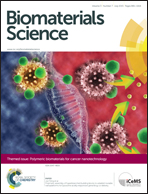Drug and gene co-delivery systems for cancer treatment
Abstract
Cancer remains a major killer and a leading cause of death in the world; thus, a growing number of new treatments have been focused on cancer therapy over the past few decades. Chemotherapy, which is thought to be a powerful strategy for cancer treatment, has been widely used in clinical therapy in recent years. However, due to the complexity of cancer, a single therapeutic approach is insufficient for the suppression of cancer growth and migration. Therefore, increasing attention has been paid to the use of smart multifunctional carriers and combinatorially delivers chemotherapeutic drugs and functional genes in order to maximize therapeutic efficiency. Combination therapy using selected drugs and genes can not only overcome multidrug resistance and inhibit the cellular anti-apoptotic process but also achieve a synergistic therapeutic effect. Because multifunctional nanocarriers are important for achieving these goals, this review will illustrate and discuss some advanced biomaterial nanocarriers for co-delivering therapeutic genes and drugs, including multifunctional micelles, liposomes, polymeric conjugates and inorganic nanoparticles. In addition, the challenges and future perspectives for co-delivery systems, containing therapeutic drugs and genes to achieve better therapeutic effects for cancer treatment will be discussed.

- This article is part of the themed collection: Polymeric biomaterials for cancer nanotechnology

 Please wait while we load your content...
Please wait while we load your content...